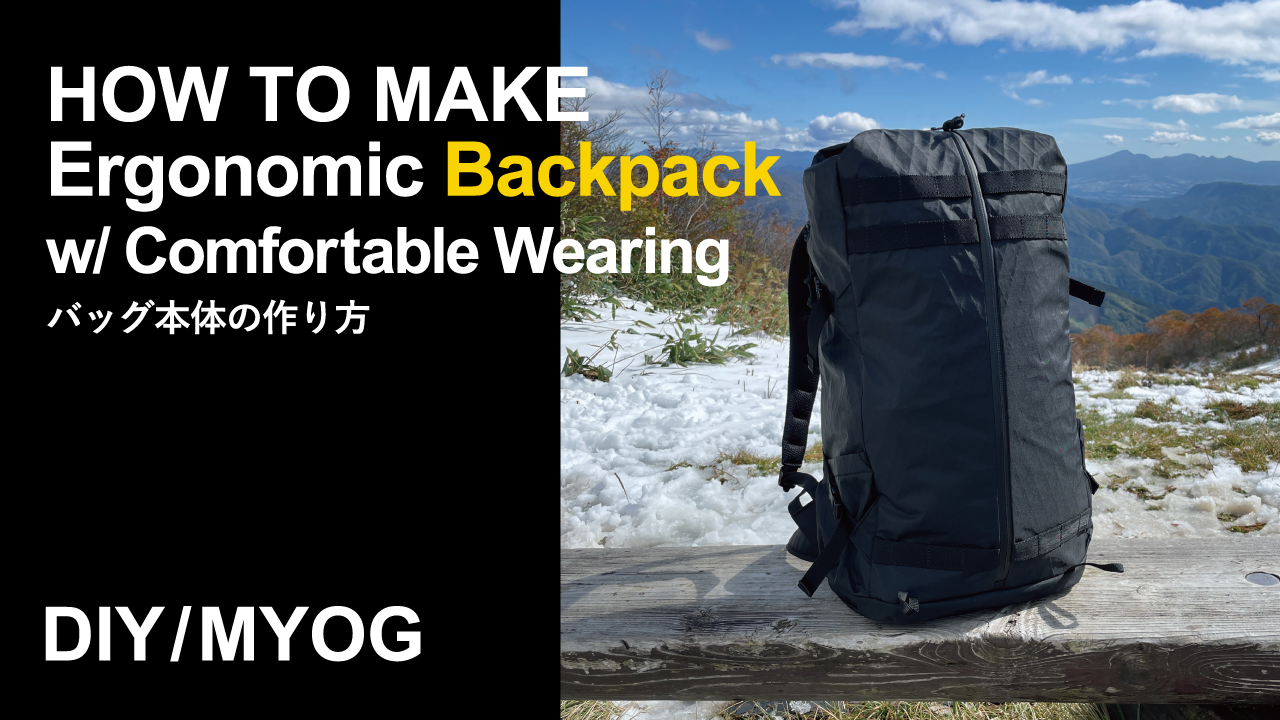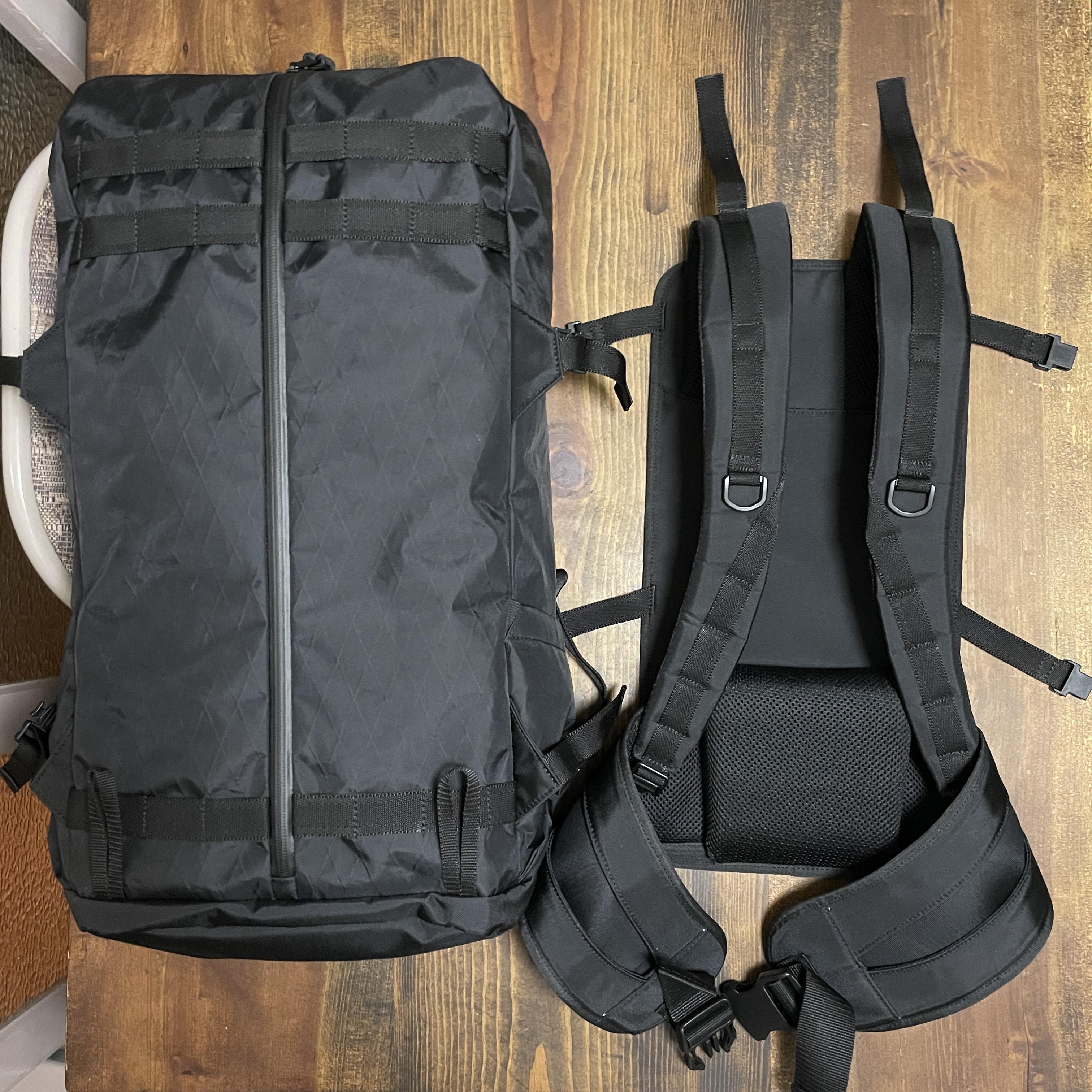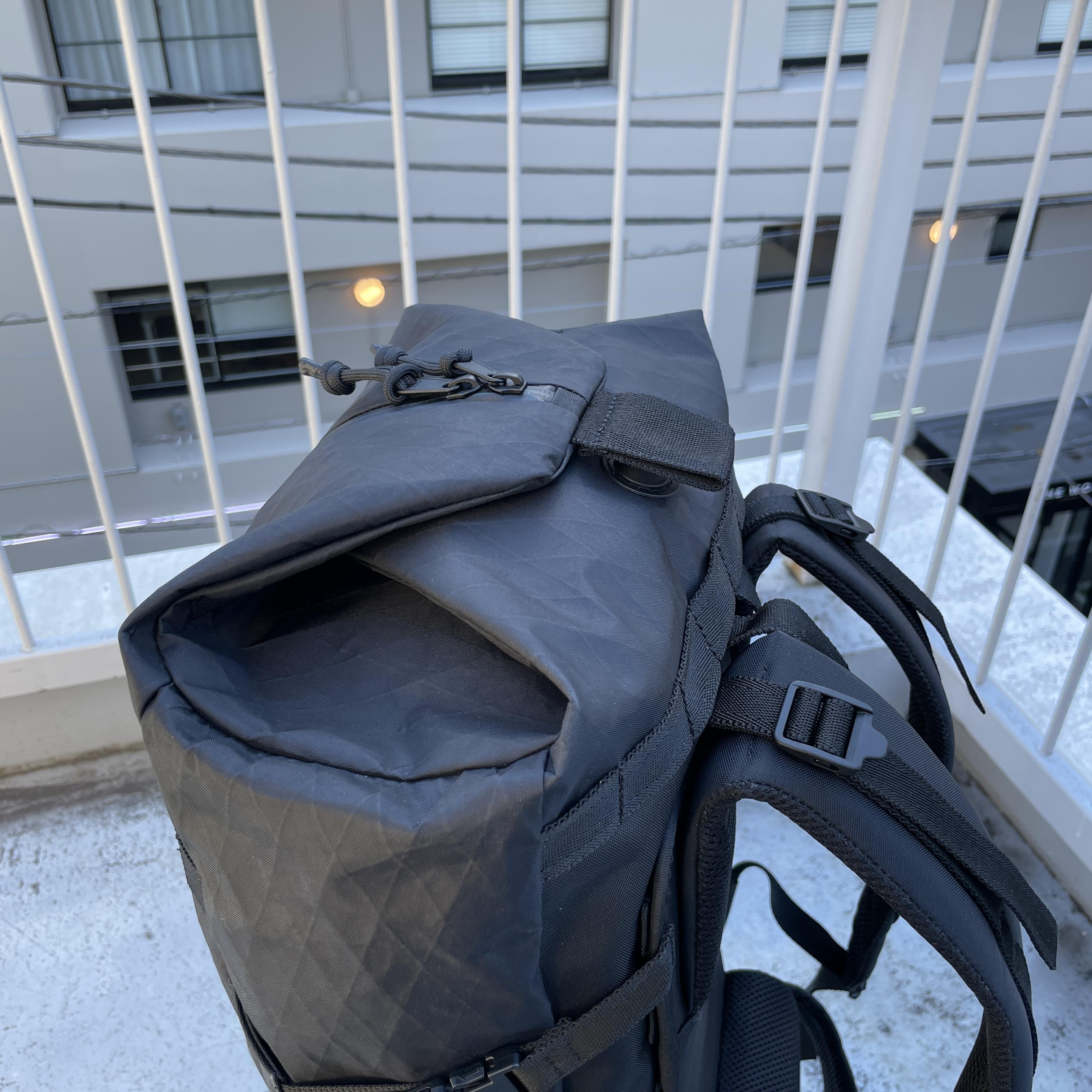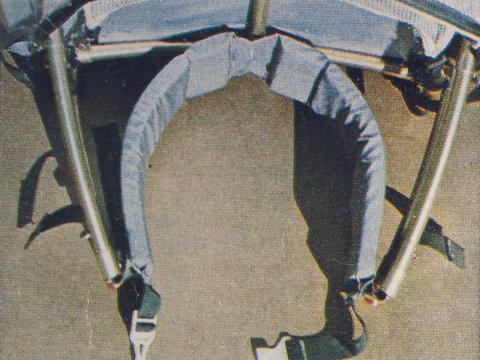Topic
An Ergonomic Backpack with Comfortable Wearing
Forum Posting
A Membership is required to post in the forums. Login or become a member to post in the member forums!
Home › Forums › Gear Forums › Make Your Own Gear › An Ergonomic Backpack with Comfortable Wearing
- This topic has 20 replies, 6 voices, and was last updated 2 years, 9 months ago by
 Nenta WAKO, Dr.Eng..
Nenta WAKO, Dr.Eng..
-
AuthorPosts
-
Mar 7, 2022 at 7:37 am #3742558

I have released a series of MYOG backpack tutorial videos, based on my research results and engineering.
I believe that comfortability while wearing backpack depends on designs of contact portions. Of course, ways of packing, avoiding movement of baggage inside, and the bag design that solves them is important. But sometimes we have to carry more than we intend or carry baggage under unexpected situations.
Even in such a situation, if load was applied to contact portions properly with better design, users can carry backpack keeping adverse effects lower.
I have proposed a natural fit shoulder strap that has different stiffness layers, a firm hold hip belt that keeps drawing bag body towards users body, and a back panel with lumbar pad that distributes shoulder load to the lower back and provides effective ventilation.


Additionally, I have released a bag body tutorial that integrates the parts. I would be grateful if you would watch these videos.
YouTube channel: Backpack Researcher
Mar 7, 2022 at 1:44 pm #3742592I have learned from your video that I would never, never have the patience to make one of those…
Mar 9, 2022 at 2:49 am #3742730“… users can carry [a] backpack keeping adverse effects lower.”
” … I would never, never have the patience …”
Glad someone has alerted packers to the long term adverse effects of conventional backpacks.
As for patience, note that the video clips are somewhat repetitious, and the OP is making his own hip belts and shoulder straps. Contoured belts and straps can be purchased ready made, and for me, have worked just as well, maybe better than home-made. And after all, this is MYOG, and often involves major investments of time.
In his video clips, the OP shows diagrams of the belt resting on the Iliac crests; so understands the anatomy. However, he may not see the importance of using the Iliac crests to support a platform on which ALL of the load rests. Thus making the ‘weight plate’ irrelevant, because there is no weight to put on the plate. There are no ‘adverse effects’ on the back when none of the weight rests on the back. But should note that the center of the pack’s gravity must be kept on the low side to avoid its becoming overly top heavy
Can almost hear the moaning when odes to the late Jack Stepenson are raised again; but he did forsee how, with the use of sidearms, a hip belt did not have to always be tied over the tummy. Sidearms fell by the wayside, however, because most moved the pack’s center of gravity too far backwards, which has ill effects just as damaging as a ‘weight plate.’ I followed a hiker wearing one of Jack’s packs on a very gradual climb up to the tableland below “the window” in the Weminuche Wilderness in the Colorado San Juans, and saw the difficulty he was having without tightening the partial hip belt around his waist.
But Jack conceived a three point suspension. Point 1 being the center of the hip belt, attached to the pack at the small of the back, but not touching the back. Points 2 and 3 being the projections of the Iliac crests. To keep the hip belt resting on the crests, sidearms were used to suspend the sides of the hip belt over the crests:

What was missing was an adjustable way to hold the belt FIRMLY over the crests, and that required a cinching device that closes the sidearms just enough to keep the belt over the crests and wrap it against the body; but with the sidearms remaining partially open in the front, and not touching the body:
As with Jack’s pack, the length of the belt is tightened by buckles just behind the points of the sidearms; so that when the sidearms are tightened by the cinching device, the belt never touches the sidearms. The weight falls between the Iliac crests and the small of the back, and close enough to the back to avoid moving the center of gravity uncomfortably backward. Note that while the belt appears roughly circular in the photos, it becomes oval when the pack is worn.
This arrangement was used for several decades during which I developed newer models with improved suspensions. During this time, back pain was never an issue simply because the back was not carrying any weight. Later however, when conventional suspensions were used, represented by the ‘weight plate” in the OP’s diagrams, back pain soon developed.
The next MYOG project will be an ultralight version of the pack, and when it is eventually completed, I’ll share the details with readers of this forum. Maybe someone will market it, and we can post one on the Gear forum. Imagine, backpacking into old age without causing back problems.
Mar 9, 2022 at 3:25 am #3742731Ratatosk,
Thank you for your comment.
I don’t have patience maybe as much as you think of me. lol
It’s a example, so you can adopt it in your preferable way!Mar 9, 2022 at 5:04 am #3742732Sam,
Thank you for your comment.
And introducing another design and your insight.The design philosophy should be different from yours.
I don’t think it’s always right for pelvis to support all backpack load. I emphasize its loading barance for avoiding greate disturbance of natural motion.
Surely, the shoulder load is transmitted as compressive load on the lumber disks. But they act as a buffer that permits natural body motion. I have also learned pelvic motion is restricted for compensation of the load distribution onto the pelvis.My hip belt design in the video is not intend to apply backpack load on iliac crest, but it only puts the backpack on the sacral slope, fixing the belt to the bulge of iliac crest. So, the hip belt is thin and does not have a buffering function as you can see.
In my research, the target of pack weight whose design assumed is less than 25% of body weight. And user also assumed the person who can apply the load on both soulders and lower back. Those are the research limitations.
Mar 9, 2022 at 1:57 pm #3742783Re: “My hip belt design in the video is not intend to apply backpack load on iliac crest, but it only puts the backpack on the sacral slope, fixing the belt to the bulge of iliac crest.”
That is what I thought from looking at the diagrams on your video clips. You also stated, “I don’t think it’s always right for pelvis to support all backpack load.” If by ‘pelvis’ you are referring to the lumbar spine, I agree. But that is the reason for my design; namely, to take the weight and stress off the lumbar spine and direct it from the Iliac crests through the hip and lower joints to the ground.
That leads to the question of whether the load can be transmitted via the Iliac Crest to the legs without causing damage to the lumbar spine. And that is why I reached no conclusions and monitored the effects of the design on my body for several decades. But there was no pain or other evidence of such damage, possibly because no weight was placed on the lower lumbar spine, not to mention the rest of the back. Of course weight was transmitted through the hip and knee joints; but there was no evidence of pain or damage there either. So for me at least, much more enjoyment from backpacking was gained when the pressure of weight bypassed the lumbar as well as the cervical spine.
As noted, when I much later tried more conventional pack suspensions, evidence of pain and damage reappeared, and I went back to the design I have posted about here. At one time, I was carrying weights above 50 lb. with this design without any problems. As I got older, the weight was lowered almost by half, which is why I am working on a much lighter pack weight, using prebent Easton 340 tubing for a frame that supports a suspended mesh back panel, somewhat like the Osprey designs, but better in terms of moving the transmission of weight away from the back and lumbar spine. Although Osprey has more recently attempted designs that are a hybrid between a sidearm and a non-sidearm suspension.
In any case, I have found that the air space behind a suspended mesh back panel is more comfortable and easier on the back than foam. With care it can be constructed without moving the center of gravity backward, and causing the shoulder straps to pull backward on the upper body. Granted, there are many who feel otherwise, especially if the mesh back panels are stretched too tightly, or allow too much space between the back panel and the pack. But if the frame is flexible enough, that has not occurred.
Still, I was concerned about the hip and knee joints, but no issues arose, possibly because backpacking greatly increases the musculature around those joints, which no matter the design, are affected by transmission of weight from the pack to the ground.
So it is agreed that with any design, reduction in carry weight, with less pressure on the back, can only be a benefit. No doubt that has much to do with the name chosen for this website: Backpacking LIGHT.
Mar 9, 2022 at 4:19 pm #3742798Pelvis that I mentioned is pelvis, not lumbar spine.
I understand your opinion. Reducing the compressive load or shear load applied to the lumbar spine is effective. And removing the load at all is its extreme situation.
But I repeat the importance of balance between performance of walking motion and loading pelvis.Pelvis carry trunk while walking and moves three axis direction periodically like sin curve. It includes forward rotation.
If ilium supports heavy load, the range of motion becomes smaller and also the relative phase between pelvis and thorax becomes smaller. It means that user is restricted his or her motion even in tricky terrain and consumes energy more.And iliac is not suitable for supporting vertical load in anatomical shape from an aspect of its acute angle. It requires large restrictions of pelvis and as a result, hip belt requires considerations for contact force such as conventional backpacks.
I understand your opinion. But do you understand the compensation that will be brought your pack (I don’t know the details) to you?
The effect of certain design is realized under some limitations.Mar 9, 2022 at 5:06 pm #3742803Great job with the video! I recognized you from another post advocating for the binder attachment you use in the video. How do you like it? Looks like it works well in the video!
Also, having a flatbed machine certainly makes sewing the bottom panel much easier. Good job!
Mar 10, 2022 at 3:48 am #3742849Eric,
Thanks! Just as the distance information between needle hole and attachment that I sent the store, it seems to have a proper distance to a walking foot and it can also bind small curve.
My working space is too narrow to add a flatbed machine. So, I plan to add a flatbed table attachment on the cylinder arm of my machine.
Mar 10, 2022 at 4:55 am #3742850Two questions:
1) Do I hear you correctly that you are arguing that placing as much load as possible on the iliac crest is counterproductive and that it is better to distribute some weight on the shoulders?
2) What is the total pack weight your designs are optimized for?
Thank you for sharing your work with us. I find your approach interesting.
Mar 10, 2022 at 6:01 am #3742855matthew,
I respond your question.
1. I think that it is preferable for sacral region to support the load rather than iliac crest when loading on pelvis.
And I think the backpack load should be distributed to the pelvis positively, if it doesn’t disturb the pelvic motion.
But if it does, the shoulders also should support the backpack load as far as the load that doesn’t elicit shoulder pain.2. Regarding the design I suggested, It is effective at least in the pack weight less than 20% of users body weight.
Mar 10, 2022 at 7:23 am #3742858I think I understand. You are loading the sacral region by employing a thick lumbar pad rather than supporting the pack with a stiff/tight hipbelt resting heavily on the illiac crest. Is that correct?
Mar 10, 2022 at 7:33 am #3742861Yes, it is the design concept of this pack. How do you think?
Mar 10, 2022 at 9:50 am #3742874I’ve never had a pack with an aggressive lumbar pad but I have found that I like creating bump at the bottom of a frameless pack so that it really locks into the lumbar region when I tighten my hip or waist belt.
My typical maximum load is nowhere near 20% of my body weight.
Mar 11, 2022 at 9:51 am #3742968The hip belt that I introduced is firmly holding the backpack to the pelvis.
Please try it!Mar 11, 2022 at 10:02 pm #3743001A couple more points:
There are packs in the stores with large lumbar pads. But I have concerns about the constant constant pressure and rubbing against the sacral area.
Also, please note from the photos above, that the partial belts rotate alternately up and down when walking. So it is not like having the whole pelvis wrapped in a tight sleeve. For me this is much more comfortable; but granted, this could be different for other hikers.
Mar 11, 2022 at 11:46 pm #3743002Sam,
The pack that I have introduced is for MYOG (simplified) version. Hip belt is thin, so it can be easily twisted at the side of the lumbar pad corresponding walking motion, while keeping firm hold on the pelvis. It remains a possibility of rubbing the sacral region.
But in the same method, there is a less abrasion lumbar pad that I developed. It moves in the same motion range of pelvis.
https://www.ace-dot.com/series/lumbar_moving_system.php
The pack on the link doesn’t have a hip belt but can install to the lumbar pad. And the hip belt that I’ve introduced doesn’t require too much tightening that increases inwards pressure around pelvis. The upper part and lower part of iliac crest were held firmly due to the slit and the pack is drawn towards the back.
Mar 28, 2022 at 9:19 am #3744506Thank you for the time and effort. There’s a certain amount of glutton for punishment, at least for me, mentality that must addressed for someone to strap a dozen kilo’s onto ones back for however long of a journey. So any help toward innovating a more comfortable carry is very much appreciated. Thanks again. ~RL
Mar 28, 2022 at 11:29 pm #3744628Sorry I missed your follow-up. Other pressing matters intervened. Glad to see that you have made some improvements, and wish you well in your efforts. Designing sturdy and comfortable packs and other gear does involve “a certain amount of glutton for punishment,” as Regis says. But where would they be without us?
Apr 17, 2022 at 7:18 am #3746695Regis,
Thank you for your comment.
I hope my post would be your help.Apr 17, 2022 at 7:25 am #3746696Sam,
It’s okay. And I was glad to exchange opinions with you.
I will keep investigating and developing backpack technology.
Thanks. -
AuthorPosts
- You must be logged in to reply to this topic.
Forum Posting
A Membership is required to post in the forums. Login or become a member to post in the member forums!
Our Community Posts are Moderated
Backpacking Light community posts are moderated and here to foster helpful and positive discussions about lightweight backpacking. Please be mindful of our values and boundaries and review our Community Guidelines prior to posting.
Get the Newsletter
Gear Research & Discovery Tools
- Browse our curated Gear Shop
- See the latest Gear Deals and Sales
- Our Recommendations
- Search for Gear on Sale with the Gear Finder
- Used Gear Swap
- Member Gear Reviews and BPL Gear Review Articles
- Browse by Gear Type or Brand.







